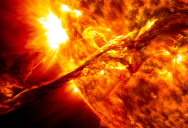New Mission Being Launched To Determine The Precise Source Of Radio Waves Coming From Our Sun

Our star, the sun, is an incredible object that provides the Earth with warmth, energy, and even a stable point around which to orbit.
While most people don’t give the sun much thought, it is quite incredible in many ways.
In addition to the constant impact it has on us, there are also events like solar flares and coronal mass ejections that can be festinating and even result in beautiful displays like the Northern Lights.
When the sun is active with these types of events, it is also doing something that many find unexpected.
It is creating radio signals.
In most cases, the source of radio signals are pretty easy to pinpoint because they can be tracked to their source on Earth.
When they come from the sun, however, it is a little more difficult. A coronal mass ejection can be so massive that the entire Earth could easily fit within it.

In addition, since we are so far away from the source, and they often happen unexpectedly, it can be hard to identify exactly where the radio signal comes from.
Scientists are working on a project to help pinpoint where these radio signals are coming from, which may help to explain what is causing them.
In addition, knowing more about them can also help to learn more about the environment surrounding distant stars and planets.
The mission is called the CubeSat Radio Interferometry Experiment (CURIE), and is being actively worked on. David Sundkvist is one of the principal investigators involved and has released a statement about it, saying:
“This is a very ambitious and very exciting mission. This is the first time that someone is ever flying a radio interferometer in space in a controlled way, and so it’s a pathfinder for radio astronomy in general.”

The mission will work by launching two CubeSat satellites, which are about the size of a toaster. Once in place, they will deploy an eight foot antenna designed to pick up the specific radio waves that are detected from the sun.
These satellites will be 360 miles above the Earth, which will get them past the interference that is caused by our atmosphere.
They will also be two miles apart from each other, allowing the scientists on the ground to accurately calculate the source of the radio waves.
The more we can learn about our sun, the better our understanding of our universe will be.
If you thought that was interesting, you might like to read about a second giant hole has opened up on the sun’s surface. Here’s what it means.

Sign up to get our BEST stories of the week straight to your inbox.




